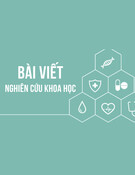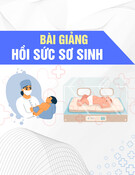
50
Tạp chí Y Dược học - Trường Đại học Y Dược Huế - Tập 7, số 3 - tháng 6/2017
JOURNAL OF MEDICINE AND PHARMACY
NGHIÊN CỨU ĐẶC ĐIỂM LÂM SÀNG, CHỈ ĐỊNH
VÀ KẾT QUẢ CỦA MỞ KHÍ QUẢN
Ngô Đức Lưu1, Nguyễn Tư Thế2 Hồ Mạnh Hùng3, Lê Thanh Thái2
(1) Bác sĩ nội trú Trường Đại học Y Dược Huế
(2) Trường Đại học Y Dược Huế
Tóm tắt
Mục tiêu: Nghiên cứu đặc điểm lâm sàng, chỉ định và kết quả mở khí quản tại Bệnh viện Trung ương Huế
và Bệnh viện Trường Đại học Y Dược Huế. Đối tượng và phương pháp nghiên cứu: Nghiên cứu 77 bệnh nhân
mở khí quản. Nghiên cứu tiến cứu, mô tả, có can thiệp lâm sàng. Kết quả: Tỷ suất nam/nữ là 4/1. Tuổi trung
bình 49. Nghề nghiệp: nông dân 44,2%, công nhân 27,2%, cán bộ công chức 14,3%, học sinh sinh viên 7,8%,
nghề khác 6,5%. Tình trạng đường hô hấp trước mở khí quản: đã đặt nội khí quản 62,3%, không đặt nội khí
quản 37,7%. Thời gian lưu ông nội khí quản: 1-5 ngày 29,25, 6-14 ngày 52,1%, >14 ngày 18,7%. Mức độ khó
thở trước mở khí quản: độ I 41,4%, độ II 48,3%, độ III 0%, không khó thở 10,3%. 26% bệnh nhân mở khí quản
cấp cứu, 74% mở khí quản có chuẩn bị. Chỉ định cổ điển 37,7%, chỉ định mới 62,3%. Vị trí mở khí quản: cao
(0%), trung bình (25,3%), thấp (74,7%). Có 44 biến chứng xuất hiện ở 29 bệnh nhân (37,7%). Viêm khí phế
quản 14,3%, tắc canule 13%, tràn khí dưới da 10,4%, chảy máu 5%, biến chứng gây khó rút ống 5,2%, tuột
canule 3,9%, chảy nước qua canule khi uống 2,6%, nhiễm trùng vết mổ 1,3%. Kết quả sau 3 tháng mở khí
quản: 33 bệnh nhân (42,9%) rút được canule. Trong 33 bệnh nhân này: thời gian mang canule từ 1 đến 90
ngày, sẹo đẹp (51,5%), sẹo trung bình (36,4%), sẹo xấu (12,1%). Kết luận: mở khí quản gặp nhiều ở nam giới,
người lớn nhiều hơn trẻ em. Chỉ định mới chiếm đa số. Biến chứng hay gặp là viêm khí phế quản và tắc canule.
Từ khóa: Mở khí quản
Abtract
CLINICAL FEATURES, INDICATIONS
AND RESULT OF TRACHEOTOMY
Ngo Duc Luu1, Nguyen Tu The2, Ho Manh Hung3, Le Thanh Thai2
(1) Resident student of Hue University of Medicine and Pharmacy – Hue University
(2) Hue University of Medicine and Pharmacy
(3) Hue Central Hospital
Background: This study aims to survey some clinical features, indications and results of tracheotomy at Hue
Central Hospital and Hue University Hospital. Patients and method: Studying on 77 patients who underwent
tracheotomy at all of departments and designed as an prospective, descriptive and interventional study.
Results: Male-female ratio was 4/1. Mean age was 49 years. Career: farmer 44.2%, worker 27.2%, officials
14.3%, student 7.8%, other jobs 6.5%. Respiratory condition before tracheotomy: underwent intubation 62.3%,
didn’t undergo intubation 37.7%. Period of stay of endotracheal tube: 1-5 days 29.2%, 6-14 days 52.1%, >14 days
18.7%. Levels of dyspnea before tracheotomy: level I 41.4%, level II 48.3%, level III 0%, 10.3% of cases didn’t have
dyspnea. Twenty cases (26%) were performed as an emergency while fifty seven (74%) as elective produces.
Classic indications (37.7%) and modern indications (62.3%). On the bases of the site, we divided tracheostomy
into three groups: high (0%), mid (25.3%) and low (74.7%). During follow-up, 44 complications occurred in 29
patients (37.7%). Tracheobronchitis 14.3%, tube obstruction 13%, subcutaneous empysema 10.4%, hemorrhage
5%, diffcult decannulation 5.2%, tube displacement 3.9%, canule watery past 2.6%, wound infection 1.3%. The
final result after tracheotomy 3 months: there are 33 patients (42.9%) were successfully decannulated. In the
33 patients who were successfully decannulated: the duration of tracheotomy ranged from 1 day to 90 days,
beautiful scar (51.5%), medium scar (36.4%), bad scar (12.1%). Conclusions: In tracheotomy male were more
than female, adult were more than children. The main indication was morden indication. Tracheobronchitis and
tube obstruction were more common than other complications.
Keywords: Tracheotomy.
- Địa chỉ liên hệ: Lê Thanh Thái, email: thslethanhthai@gmail.com
- Ngày nhận bài: 20/8/2016; Ngày đồng ý đăng: 10/2/2017; Ngày xuất bản: 18/7/2017
DOI: 10.34071
ũŵƉϮϬϭϳ
3
7








































